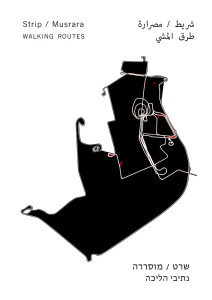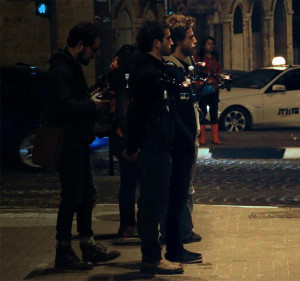Now available through Video Data Bank
Strip: Musrara is part of my ongoing “Strip” series, set in Jerusalem’s Musrara neighborhood. It is an attempt to create a living map that is both collective and subjective – a plurality of combined perspectives. Not a map of the exact measurements of the neighborhood, but of the experience of moving through it, together and alone, locals and strangers, intersecting and drifting apart. It is also a response to the prevalence of bird’s eye, all-knowing, absolute mapping and visualization tools so readily available now to anyone negotiating an unfamiliar cityscape, and to the increasingly blurred boundaries between maps, cinema, and “real time”. The form of this specific piece in the series is highly dependent on the unique stories and landscapes of Musrara.
Musrara is a neighborhood with few roads but many alleys, back passages and stairways, at the seam between east and west Jerusalem. Tenements and grand old Palestinian mansions, abandoned in 1948, are now occupied by a mix of people including young students, ultra-orthodox Jewish families, and the older generation of Moroccan Jews, who lived in the neighborhood since the 50s, when it was a mostly derelict slum in a no-mans-land near the border. Some of these were responsible for starting the Israeli Black Panther movement in the 60s and 70s, fighting for equality for Israel’s Mizrahi population, whose influence lasts to this day.
The project involves a group of three to nine “surveyors” moving through Musrara in single file, scanning the landscape with small, sideways-facing video cameras. Each person in the group generates a video “piece”. When those “pieces” are lined up next to each other, an immersive, constantly moving audio-visual panorama installation is produced. It is a personal, fragmented, rippling, expanding and contracting antithesis to the digital maps that increasingly control our geography and determine the way we perceive space. As long as the participants stay in line, the panorama is continuous. Occasionally they break rank and venture into the hidden and unmapped spaces of the neighborhood, each camera presenting an independent point of view. The view oscillates between combined real-time shots from multiple participants, to a single shot extended and delayed through time to show a rippling trace of one person’s motion, similar to the approach I used in previous Strip pieces. Inevitably, the collective panorama reforms, and continues its journey through the nooks and crannies of the neighborhood, moving from inside to outside, between day and night, always in a futile attempt to gain a total image of an unimaginably complex place. At various point conversations ensue and the piece assumes an almost documentary stance. Other moments are only about the sensation of movement through the space.
Credits: Strip / Musrara was produced with a great team of volunteers and the support of Musrara School and GoPro Israel. See here for the full credits.
Following are some installation shots:
And some still frames from the piece:
Panoramic, time delayed video installation
3 HD projections, approximate dimensions 33 x 6 feet (10 by 1.8 meters), duration 76 minutes





















